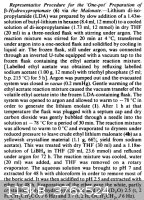FrankMartin
Hazard to Self
 
Posts: 50
Registered: 30-5-2010
Member Is Offline
Mood: No Mood
|
|
Help. Malonic ester synthesis via crossed claisen.
Theoretically diEthylMalonate can be made by condensing EthylAcetate with DiEthylCarbonate with NaEthylate.
CH3COOEt + EtOCOOOEt = MalonicEster + EtOH
But why do the textbooks (such as Vogel) use DiEthylOxalate instead of DiEthylCarbonate? The DiEthylOxalate method requires a deCarboxylation step.
Please help.
|
|
|
DJF90
International Hazard
    
Posts: 2266
Registered: 15-12-2007
Location: At the bench
Member Is Offline
Mood: No Mood
|
|
The enolate of ethyl acetate would condense in preference with another molecule of ethyl acetate than with a molecule of diethyl carbonate. Using the
form XCO2Et, where X=Me for ethyl acetate, X=OEt for diethyl carbonate and X=CO2Et for diethyl oxalate, then we can compare the electrophilicity of
the carbonyl functionality in all three cases. Comparing X=OEt with X=Me, the additional alkoxy group contributes to mesomeric stabilisation of the
carbonyl, making it less susceptable to nucleophilic attack, and thus the enolate of ethyl acetate would condense faster with another molecule of
ethyl acetate than with diethyl carbonate. When X=CO2Et, the inductive withdrawing effect of the carboxylate group increases the electrophilicity at
the adjacent C=O bond, and so diethyl carbonate will react faster with the enolate of ethyl acetate than ethyl acetate itself would.
|
|
|
FrankMartin
Hazard to Self
 
Posts: 50
Registered: 30-5-2010
Member Is Offline
Mood: No Mood
|
|
Thanks. Is it that EtOxalate has two carboxy groups per molecule, and so has two electrophilic sites and so is twice as likely to react with EtOAc ?
Or does the two carboxy sites of EtOxalate give a net reactivity per molecule greater than the sum of the parts? You seem to imply this.
For competing reactions, the self-condensation of the EtOAc can be suppressed by adding this slowly to the catalyst/EtCarbonate mixture, so that the
EtOAc is more likely to react with the other reactants (EtCarbonate) rather than with itself?
Frank
|
|
|
DJF90
International Hazard
    
Posts: 2266
Registered: 15-12-2007
Location: At the bench
Member Is Offline
Mood: No Mood
|
|
Both carbonyl groups in the oxalate ester will have the same reactivity, and so you're right in saying theres two sites for reaction. But each site is
also more reactive than that of ethyl acetate, because the adjacent CO2Et inductively withdraws electron density from the other carboxy group in the
oxalate, and vice versa - the effect is mutual. As for your suggestion, sodium ethylate cannot be used as a *catalyst* - the Claisen condensation
(like the Aldol) is a reversible process and so to drive the material to the product you need a stoichiometric amount - this allows for deprotonation
of the malonate which drives the process to completion.
|
|
|
smuv
National Hazard
   
Posts: 842
Registered: 2-5-2007
Member Is Offline
Mood: Jingoistic
|
|
How does the condensation of ethyl acetate and ethyl oxalate lead to malonate?
Claisen
Ethyl acetate + diethyl oxalate --> diethyl oxaloacetate
Hydrolysis
Diethyl oxaloacetate + 2H2O --> oxaloacetic acid + 2 H2O
Decarboxylation
Oxaloacetic acid --heat--> CO2 + Pyruvic acid
|
|
|
DJF90
International Hazard
    
Posts: 2266
Registered: 15-12-2007
Location: At the bench
Member Is Offline
Mood: No Mood
|
|
There is a decarbonylation reaction sees use on several occasions in OrgSyn. Here is probably the most applicable one to the original poster's
question: http://orgsyn.org/orgsyn/prep.asp?prep=cv2p0288
and another:
http://orgsyn.org/orgsyn/prep.asp?prep=cv2p0531
[Edited on 2-2-2011 by DJF90]
|
|
|
smuv
National Hazard
   
Posts: 842
Registered: 2-5-2007
Member Is Offline
Mood: Jingoistic
|
|
Neat. Thanks for the refs.
P.S. I did a scifinder search, that showed some condensation between ethyl acetate enolate and carbon dioxide, forming HOOC-CH2-COOEt. Also, if you
quantitatively deprotonate the ethyl acetate with stoichiometric amount of base (or a slight xs), you will get very little homo-coupling because ethyl
acetate enolate is such a shitty electrophile; this would allow for crossed claisens using less electrophilic substrates.
[Edited on 2-2-2011 by smuv]
Edit: Here is the procedure. But you know...it seems kind of silly to use LDA or another base capable of deprotonating ethyl acetate, just to make
plain 'ol malonate...
(J. Chem. Soc., Perkin Trans. 1, 1986, 521-524)

[Edited on 2-2-2011 by smuv]
[Edited on 2-2-2011 by smuv]
|
|
|
FrankMartin
Hazard to Self
 
Posts: 50
Registered: 30-5-2010
Member Is Offline
Mood: No Mood
|
|
Quote: Originally posted by DJF90  | | Both carbonyl groups in the oxalate ester will have the same reactivity, and so you're right in saying theres two sites for reaction. But each site is
also more reactive than that of ethyl acetate, because the adjacent CO2Et inductively withdraws electron density from the other carboxy group in the
oxalate, and vice versa - the effect is mutual. As for your suggestion, sodium ethylate cannot be used as a *catalyst* - the Claisen condensation
(like the Aldol) is a reversible process and so to drive the material to the product you need a stoichiometric amount - this allows for deprotonation
of the malonate which drives the process to completion. |
Thanks. I have been reading the US patent
2,454,360 which gives numerous examples of making alkyl malonic esters, from simple ethyl carboxylates and diEthyl Carbonate. The process is/was
called "carbalkoxylation".
|
|
|